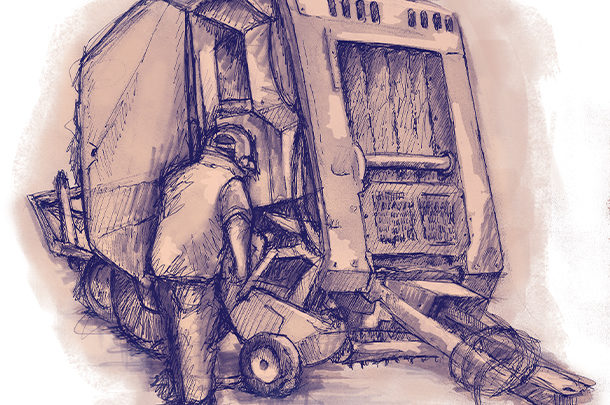You’re dreaming of a sunny day when the hay is just right, not too wet and not too dry. You are baling the perfect windrow on the perfect sunny day. Bale after bale is peppering the field – when suddenly an alarm pierces the quiet of the cab. You check your monitor and find the net is still wrapping on the bale when the net should have been cut. You shut the tractor off and go back to the baler to find the cause of the interruption to your perfect day.
This is a scenario that at some point you have encountered or will encounter. Net application may vary from manufacturer to manufacturer, but there are causes that are common between brands.
The first thought that will cross your mind is a dull knife or knives. How often should you sharpen your net knives? When a baler comes in regularly for service, I will sharpen the knives every 4,000 bales, but I have seen balers with over 10,000 bales without the knives ever being out. The crop being baled and the ground conditions will dictate for you how often to sharpen the knives.
To sharpen the knives, I use a small hand grinder with a 24-grit hard paper disc. I run the disc over the knives until I feel a burr being raised. I then finish with a flat file to remove the burr. Other methods are just as effective, but if using a grinder take care not to blue the knife edge from heat.
Now that the knives are sharp, where do you look? Net tension – or in the case of poor cutting, the lack of tension on the net as the net is being applied. Low net tension will also manifest itself when you see net not being fully spread across the bale. For your particular baler, the operator’s manual will show the proper procedure for adjusting the braking mechanism to achieve the proper tension.
When adjusting the net tension, do not just guess, follow the directions. Too much net tension can also cause a net-not-cutting issue because the added load can cause the actuators and motors to stall, preventing the system from completing the cycle.
Another consequence of low net tension or dull knives will be a ragged cut across the net that will leave long ripped strands. If the problem is severe enough, the strands of net will wrap on the belt rolls, net feed rolls or get caught in chains and idlers.
On various models, the manufacturers make it easy to connect the baler wiring harness to a power source by using an AMP three-terminal connector, which mates with the terminal connector common in most tractors. To have consistent and trouble-free operation of the wrapping system, do not use the connector in the tractor. The tractor’s wires, for the three-terminal connector in the tractor, are of a small gauge and were not designed to carry the electrical load that the actuators and motors in the wrapping system generate.
The controllers used on these machines will stop the motors and actuators when the voltage drops to a certain point to protect the sensitive electronics. With the power cut to the actuators and motors, the wrapping cycle will not complete so the net will not be cut. The power should come directly from the battery to the baler harness connector. I use 10-gauge wire if a factory harness is not readily available. If you are not using a factory power harness, you need to protect this circuit with a minimum 30-amp fuse or circuit breaker positioned as close to the battery or power source as possible.
All of the net systems being used have sensors or switches to control different aspects of the wrapping process. It is important these components be adjusted and calibrated properly for the system to process the wrapping operation correctly. Calibration lets the system know where certain components are at any given time. In the case of the balers I work on, the net knife will not be activated unless the controller recognizes that the net mechanism is in the home position. On some models, if the tailgate sensor is not adjusted correctly, the net actuator will stop moving if the system senses the tailgate opening and then the net will not be cut.
The operator’s manuals for these machines are a great source for information and can save you a costly service call. Checking the adjustments before the hay season starts will make your sunny hay-making day so much better.
Mike Seckinger has over 44 years experience as a farm equipment mechanic in southern Indiana and says, “What I write is not intended to represent the only way to solve a problem, and it may not always be complete. If you choose to follow some of my procedures, remember to always practice safety first. Wear the correct clothing and safety equipment, and use the equipment’s safety devices.”










